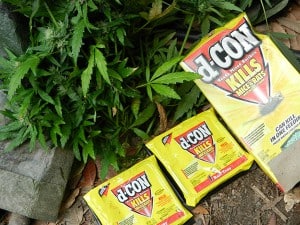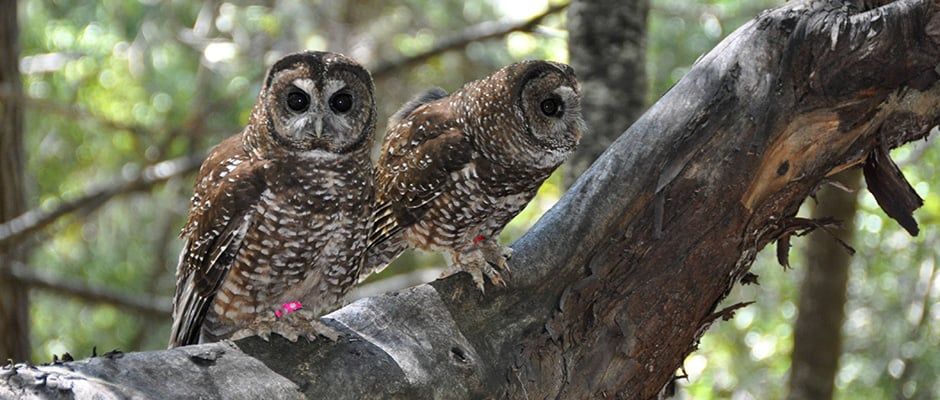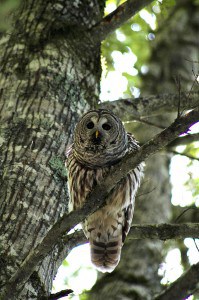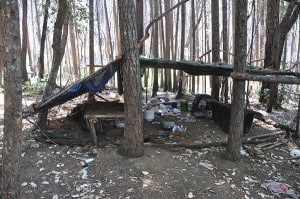Share this article
Illegal Weed Plantations May Affect Owl Recovery
Illegal marijuana plantations may not lead to high times for the recovery of a species of threatened owls, according to researchers.
The northern spotted owl (Strix occidentalis caurina) is currently listed as a threatened species under the Endangered Species Act due to threats from logging and the encroachment of the territorial barred owl (Strix varia) — an invasive import from eastern North America.
Wildlife managers are working to eradicate the barred owl from woodland from California to British Columbia in an effort to clear up more habitat for northern spotted owls, but some are worried that illegal marijuana plantations that often overlap with owl habitat may put a hitch in the bird’s recovery.
Mark Higley, a biologist with the wildlife department of the Hoopa Tribal Forestry agency and a member of The Wildlife Society, presented research on owls at a special symposium entitled “Marijuana Cultivation and its Impacts on Wildlife, Habitats and the Wildlife Profession,” at the 2015 Annual Meeting of TWS’ Western Section. As part of his research, Higley examined the livers of 84 dead barred owls in the Hoopa Valley Indian Reservation in Northwest California as well as in nearby private timber lands to see if they had ingested anticoagulant rodenticide, which illegal weed cultivators often spread liberally to protect the marijuana from wildlife. In fact, wildlife managers cleaning a grow operation in 2013 found 10 to 12 pounds of commercial rat poison. “It’s a violation of federal law to be using this out in the wild,” Higley said. But, “they absolutely don’t care.”
Higley and his team found that on Hoopa land, 62 percent of barred owls tested positive for the poison while 40.5 percent of owls on private timber land had some rodenticide in their livers. Higley said the differences could be due to the fact that the private timber land is often gated and potentially harder to access for marijuana cultivators. It could also be due to variations in density. “There are differences potentially in [Hoopa land] populations of barred owls.”

D-CON is a common anticoagulant rodenticide used sometimes in illegal marijuana plantations. This poison was found at an illegal grow operation.
Higley noted that not all poison detected in the owls necessarily comes from illegal plantations. Barred owls tend to disperse widely across the landscape and could be ingesting legally used poison through rodents near human homes.
They tested the barred owls as a proxy species since it’s not as easy to come across dead northern spotted owls that could be tested for the rodenticide. But Higley worries that the spotted owls may be more susceptible to the poison due to the fact that their diet is less varied than their barred cousins. “Spotted owls focus more on the mammalian prey, which is more likely to be affected.”
In order to find out for sure whether northern spotted owls are being affected, Higley said they’ve sent the corpses of a couple of road kill owls they’ve discovered to see whether they show similar signs of rodent poison, but the research for this is ongoing.
Endangered Researchers
It was 2009 and a research crew member was hiking by himself in Sequoia National Park when he came across a grow operation in the middle of the remote bush. He radioed back to headquarters about his find but he heard voices in his vicinity and quickly left the area. He was pursued for around 45 minutes by armed growers before he escaped, according to Craig Thompson, a wildlife ecologist with the U.S Forest Service’s Pacific Southwest Research Station.
While the goal of the illegal weed cultivators is to avoid people, their remote location can sometimes put them into direct contact with researchers and wildlife managers who work in the areas.
“We started really becoming aware of this in 2009,” said Thompson, who also spoke at the TWS symposium. They had research crews all over the place doing radio telemetry studies in an effort to track wildlife and they were coming across grow sites quite frequently.
“The obvious danger everyone wants to talk about is guns,” he said. But he’s more concerned with the potential danger from chemical exposure that researcher could suffer in these areas. They’ve found banned substances like DDT or carbamate rodenticide discarded haphazardly in plastic bottles. These could be a risk for wildlife researchers who sometimes have a natural inclination to pick up trash they come across in nature.
Owls and people aren’t the only species being affected by illegal marijuana grow operations. An article in The Wildlife Professional by Mourad Gabriel et al examined how fishers (Martes pennanti) — a species proposed for ESA listing — are being affected.
And Thompson has seen grimmer evidence. He’s found tuna cans, hot dogs and other things that test positive for rodenticides, either banned or not. Besides dead fishers and owls, he said that coyotes and bears have also been killed by these baited poisons.
“Their intent is simply to keep animals from getting into their camp,” Thompson said. “There are multiple levels of malicious activity going on.”
Higley said that people working with him have also come across marijuana workers in the middle of nowhere at night. The incidents have ended with either the weed workers or the wildlife staff speeding away, and while nobody he works with has been directly threatened, he’d like to keep it that way.
Thompson said that due to the extra level of danger, researchers now always travel in pairs — especially when going into unfamiliar areas — and know to get out of an area quickly if they come across a grow operation. They also stay in close radio contact, and try to make their official Forest Service badges and research equipment visible at all times to highlight the reason they are in the area.
Header Image:
Northern Spotted owl banded for research purposes
Image Credit: J. Mark Higley, Hoopa Forestry










